Let's discover some more of the places near our temporary home in and around Aarschot.
The little town we stay called Begijnedijk, had some notariaty as the egg-capital of Flanders. History has it that the weekly egg market in Aarschot was moved to the nearby Begijnendijk in 1964, where it was organized every Thursday from then on in the purposely built open egg-hall. The egg market did not turn out well in the long term. The first egg hall collapsed and a second suffered the same fate. Until it was finally discovered that those constructions were built on the remains of an old graveyard. Kruishoutem became the new Flemish capital of the egg,
According to history, the oldest permanent settlement in Begijnendijk dates to the lower Middle Ages, when the domain was shared among the Van Uythem family, the abbey of Averbode and the Beguine convent of Aarschot. The Beguine's domain was crossed by a heightened road, locally called a dyke, which gave its name to the village, literally "the Beguines' dyke"!
In the XVIIth century, the Van Uythem estate was transfered to the Percy family, descendant of the Count of Northumberland. Potatoes were grown for the first time in the region in the Van Uythem estate.
Until the French Revolution, Begijnendijk depended on Aarschot; on 8 March 1796, the French administration made of Begijnendijk an independent municipality.
In the middle of the XIXth century, most inhabitants of Begijnendijk lived from agriculture. In 1864, the railway line Antwerp-Liège was built, with a station in Aarschot, which allowed the villagers to work in the port of Antwerp and the coal mines of Limburg and Liège. In the XXth century, small industries were set up in the village; a sausage manufacture, cigar manufactures, diamond-cutting workshops and breweries. However, agriculture remained the most important activity.
Today however, dependancy on agriculture has become almost nihil. There is still a brewery, Wolf brewery. Begijndijk now advertises itself as a tourist spot; campsites with sport fishing, bicycle routes and the town's own sports and recreational infrastructure.
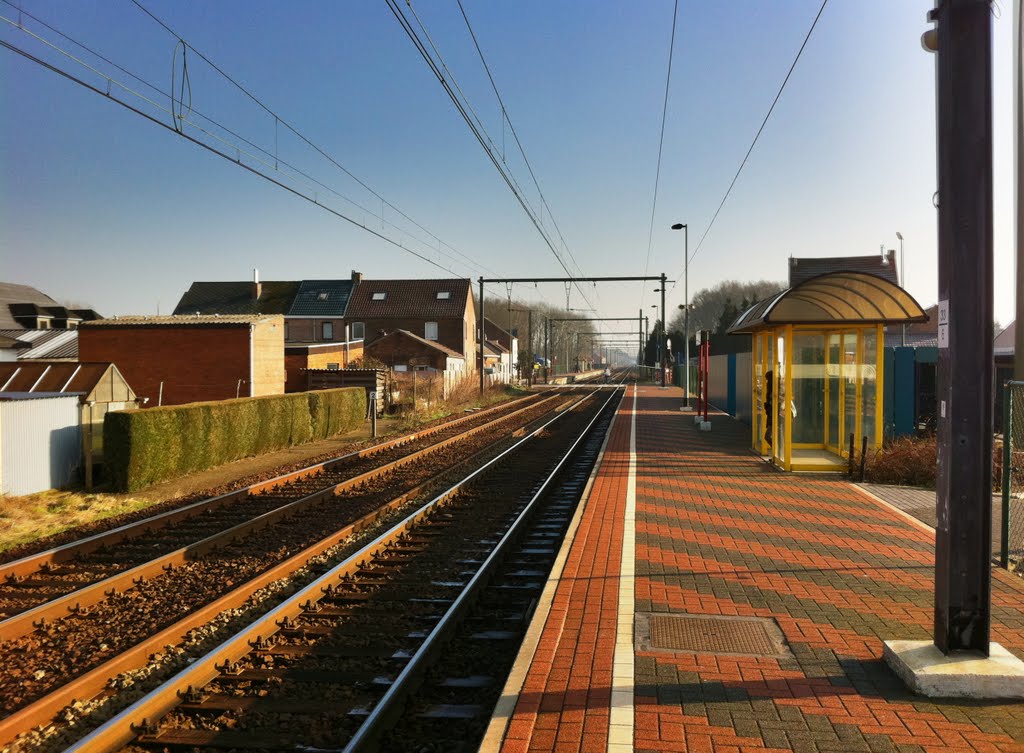
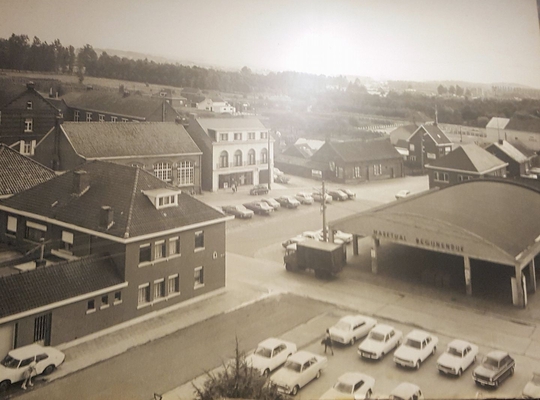 The infamous egg hall, seen from the church tower. The hall location is now a parking lot.
The infamous egg hall, seen from the church tower. The hall location is now a parking lot.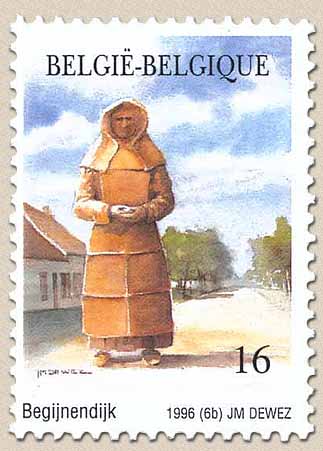 A postal stamp was issued in the 90's shining light on the Beguines past.
A postal stamp was issued in the 90's shining light on the Beguines past.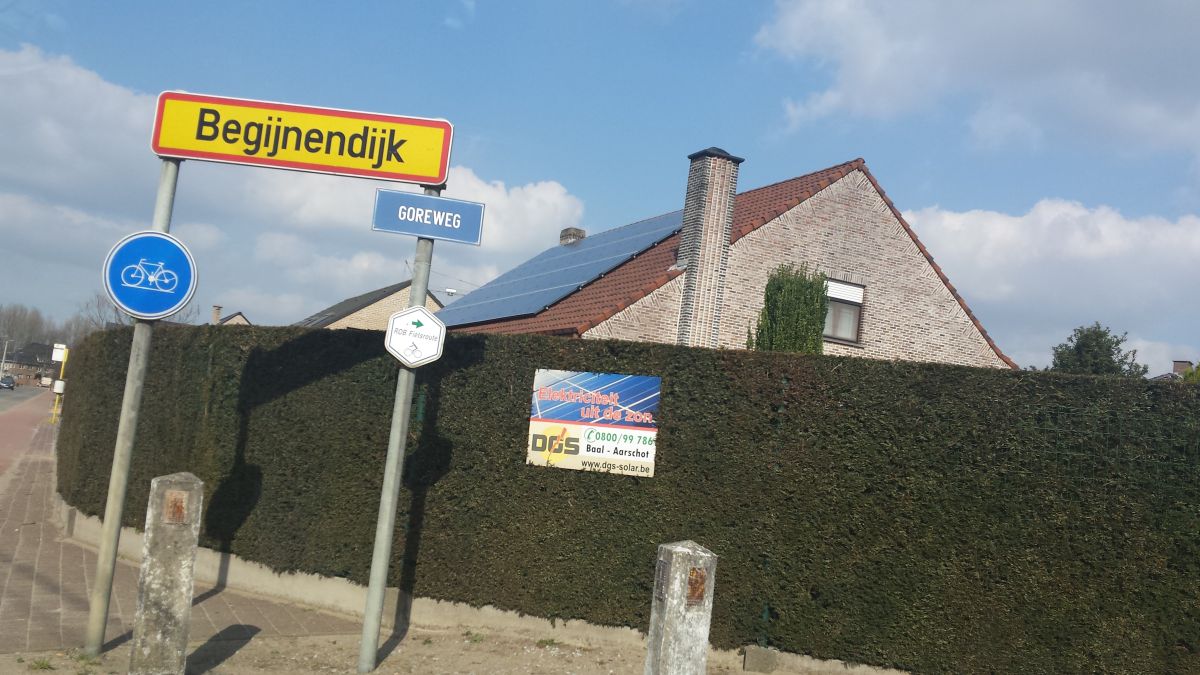 Yes we are here. Street sign indicating you're entering Begijnendijk
Yes we are here. Street sign indicating you're entering Begijnendijk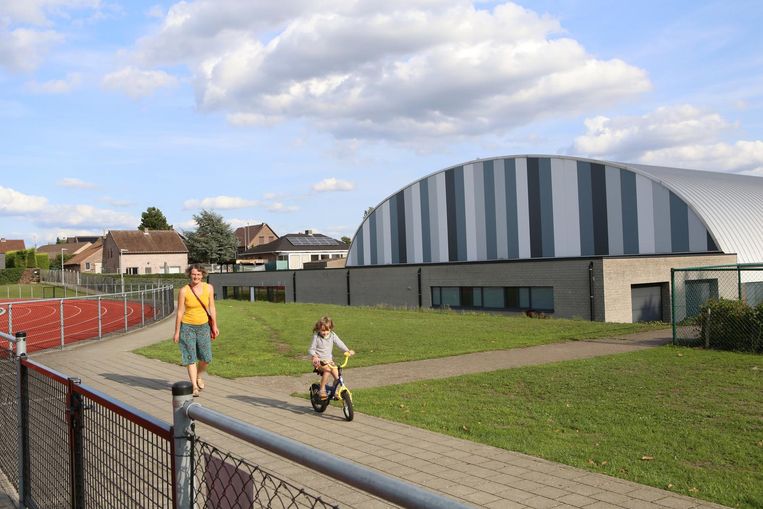 Town's Sports complex
Town's Sports complex
Enough of Beguine-dyke! Move to the Abby of Averbode. A well know place in this part of Belgium. The town of Averbode also popular for its walking routes in the surrounding forests and heather. And that comes with eateries and pubs. Not to forget the ice cream trucks in the summer, irresistable!
The Abby of Averbode is home to the Norbertines order and known for its publishing company and has an Abby beer named after it! The old service buildings were given a new purpose. Now they are the home to an abbeycafé with a brewery, a cheese factory, a bakery and an abbey shop. Several information carriers introduce you to the abbey life, a publishing and living tradition in agriculture and food.
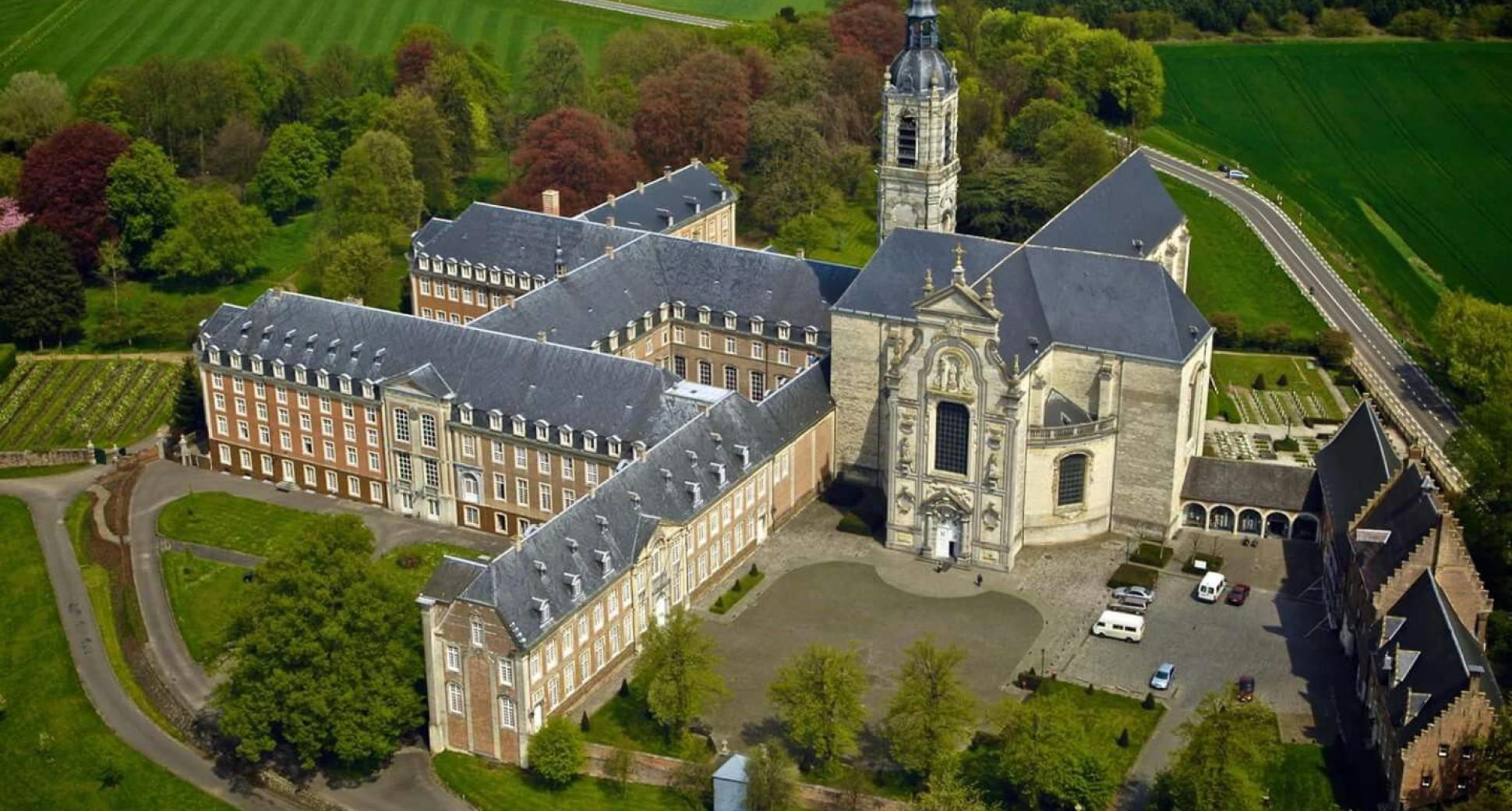 Arial view of the Abby
Arial view of the Abby.jpg) Interiors of the Church
Interiors of the Church.jpg) Church entrance
Church entrance.jpg) Interiors of the Church
Interiors of the Church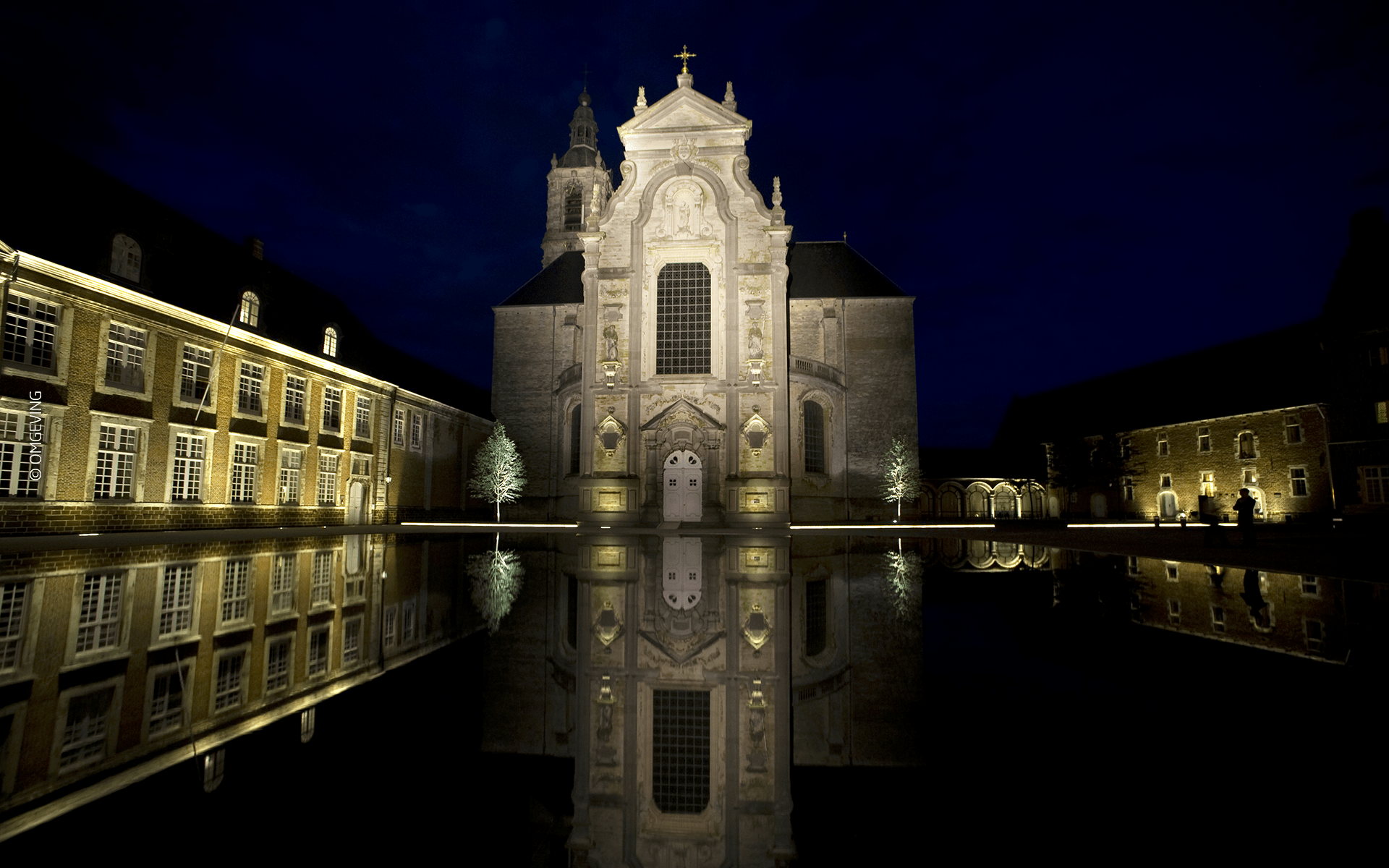 Impressive night view from the courtyard. The Norbertines certainly have taste for art.
Impressive night view from the courtyard. The Norbertines certainly have taste for art.History
Averbode Abbey has a rich history which already spans ten centuries. It was founded in 1134 on the initiative of Arnold II, Count of Loon. Its activities soon included agriculture to ensure its sustainability. Over the centuries however, the abbey faced many trials such as looting, fires and the plague. Indeed, in the late 18th century it was even sold and demolished. From the 19th century onwards the abbey began to flourish once more. Monastic life was resumed and it became the hub of many activities such as missionary work and a publishing house. In the 20th century, the Norbertine monks founded different schools. Today Averbode Abbey faces a bright future with a wide range of products and a brand new experience centre.The Norbertines
The monks at Averbode Abbey belong to the order founded by Saint Norbert. Which is why they are called Norbertines. However, they are also known by several other names. The name Premonstratensians for example refers to Prémontré, the French town where the order was founded in 1121. Their white habit has also earned them the nickname witheren (white men). Like Jesus, the Norbertines’ aim is to spread the gospel in a way that will allow people to draw courage and confidence from it. At the same time they also wish to live the gospel together, as brothers, in a community that offers prays and services. In their lives they strive for unity between community life, prayer and pastoral commitment.
Brother Willy (Rest In Peace brother) invited us for a dinner that evening. It was an oppertunity to present Jasmen, fiancee at the time. Willy trumped up his sons Hans, Francis and Johan for the occasion. The dinner table needed extension to accomodate everybody.
At coffee time Willy insisted on making pineapple-upside-down-tarts and teaching Jas how to make them. The evening went on sharing stories and lifting a few glasses of beer. Fortunately no police on the way home.
.jpg) Pinapple cuts and brown sugar on a platter covered with alufolie
Pinapple cuts and brown sugar on a platter covered with alufolie.jpg) Poor over the prepared tartmix
Poor over the prepared tartmix.jpg) Chef Willy teaching Jas
Chef Willy teaching Jas.jpg) Baking to perfection
Baking to perfection.jpg) Quality check
Quality check.jpg) Et voila! The end product ready to be consumed
Et voila! The end product ready to be consumedAnother day, another discovery. Willy suggested to visit the Castle of Horst. He has some fond memories of the place where he and Josee went boating on the lake together. What happened before, during and after the boating is still a mistery {fa-venus-mars }. But first the car needs a cleanup. A visit to one of the "Do It Yourself carwash" in Aarschot industrial zone is next.
.jpg) Instruction on how to use the DIY carwash
Instruction on how to use the DIY carwash.jpg) Do your thing
Do your thing.jpg) After washing, Vacuum the interior
After washing, Vacuum the interior.jpg) Assistant helping out
Assistant helping out.jpg) Flip in another coin dear
Flip in another coin dear.jpg) Long vacuum hose.
Long vacuum hose.Ready to continue with a good-as-new looking car. The Castle of Horst is located in Holsbeek, just outside Aarschot. On arrival a sign board reads the castle is closed due to some reason i don't remember. According todays websites (year 2020) the castle is under renovation. No problem, we just stroll around the property and take a few pictures.
.jpg) Smart-phone picture of the castle
Smart-phone picture of the castle.jpg) Jas strolling in front of the lake surrounding th castle
Jas strolling in front of the lake surrounding th castle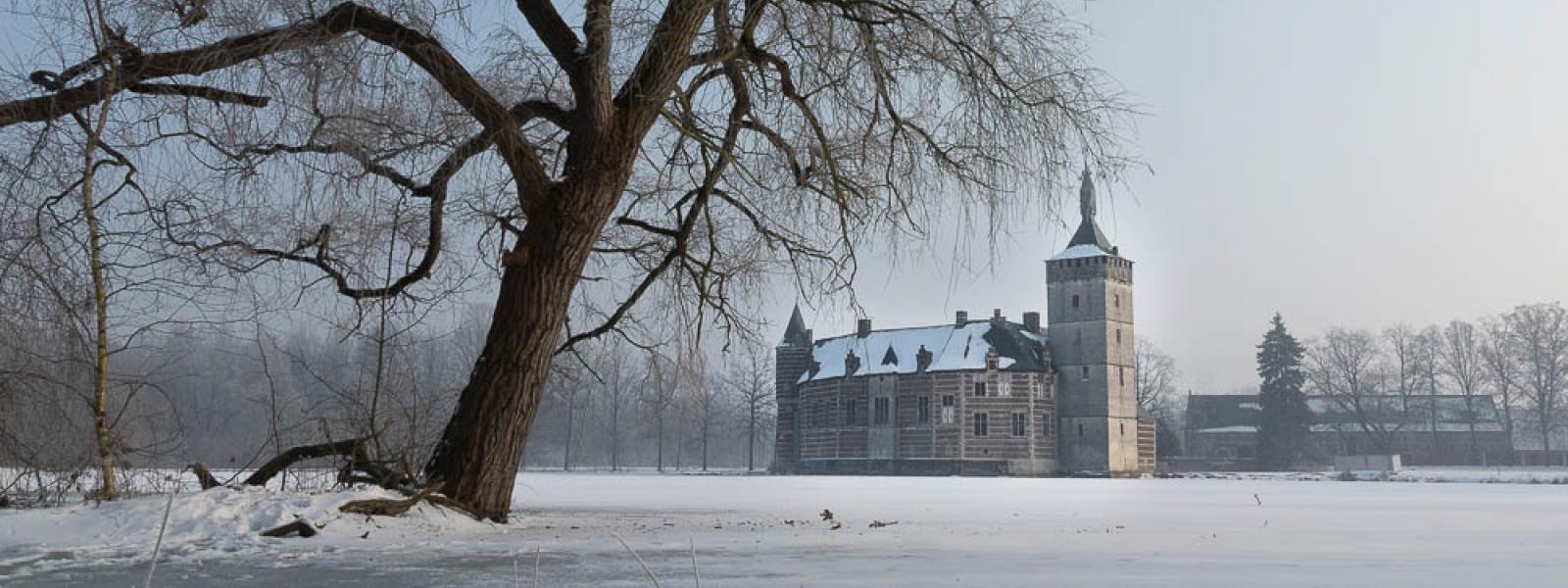 This winter version takes you back to 17th century, Lady Maria-Anna waiting for her knight on white horse to arrive...
This winter version takes you back to 17th century, Lady Maria-Anna waiting for her knight on white horse to arrive... Castle of Horst History
The origins of the castle are unclear. A "castellum Rode" is mentioned in 1100, but the name Horst does not show up until 1268.
Like most late medieval castle built in a plain, Horst castle was constructed as an irregular polygon surrounded by a wide moat. Nevertheless, all the feudal castle but the dungeon burnt down in 1489 during the war between Emperor Maximilian of Austria and the citizens of Leuven.
A Renaissance-style castle was rebuilt in the late 16th century, keeping the original layout. In the 17th century, the castle was owned by Maria Anna Van den Tympel. She built a new chapel and decorated the ceiling of banqueting hall. Horst castle was only inhabited until the mid-17th century, and as a result there is no furniture inside nowadays.
While in the area of Westerlo, A visit to the Abby of Tongerlo is a must. This Abby is a larger version of the Abby of Averbode. Both Abby are run by the Norbertines order. The courtyard is surrounded by the church, large buildings and small quarters. A shop selling books and religious items. A barn on the courtyard is setup as a display of the history and life in the monistary.
Since 1545 the abbey is in the possession of a remarkable work of art: the most faithful and the most beautiful replica of the 'Last Supper', the original painted by Leonardo da Vinci in the refectory of the monastery Santa Maria delle Grazie at Milan. This replica of the 'Last Supper' has become even more precious because the original work has suffered so much throughout its history, that unfortunately, most of the original beauty has been lost.
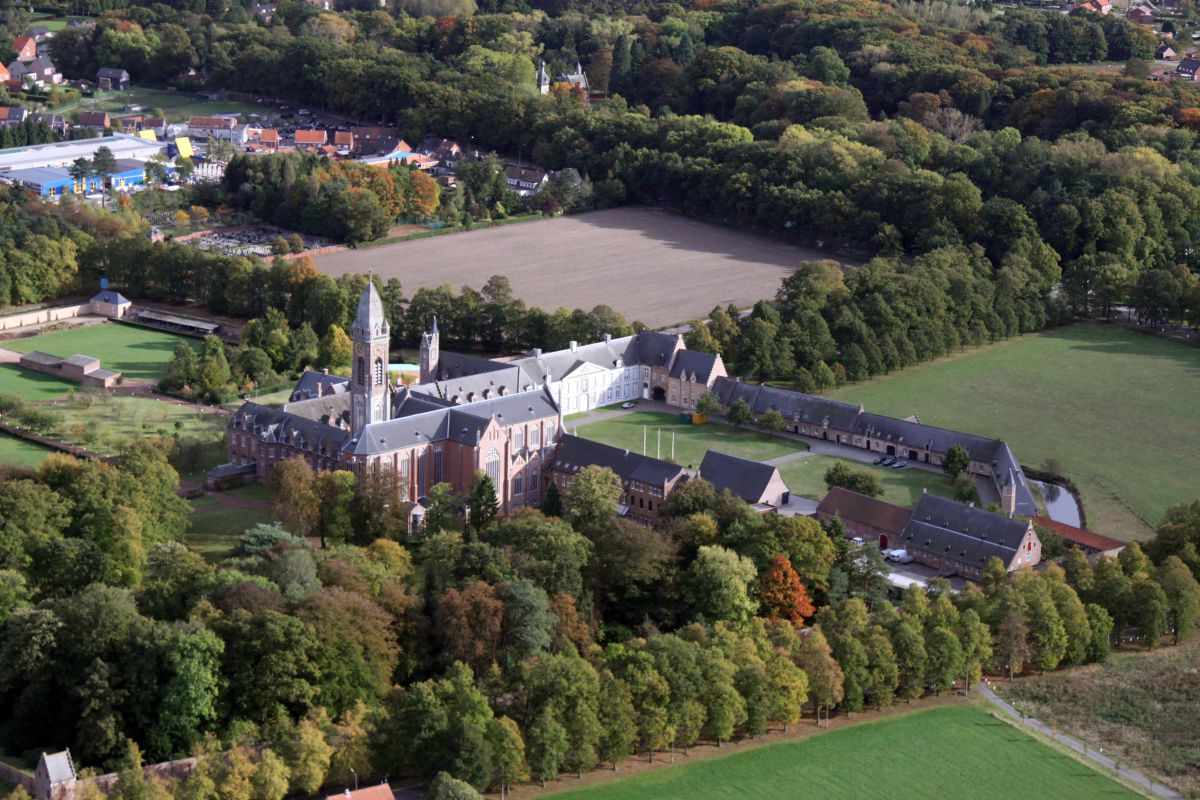 Aerial view of Abby of Tongerlo.
Aerial view of Abby of Tongerlo..jpg) The main entrance to the courtyard
The main entrance to the courtyard.jpg) View of the courtyard from the shop
View of the courtyard from the shop.jpg) View of the courtyard from the entrance
View of the courtyard from the entrance.jpg) White facade building with an Emblem reading "Festina lente"
White facade building with an Emblem reading "Festina lente"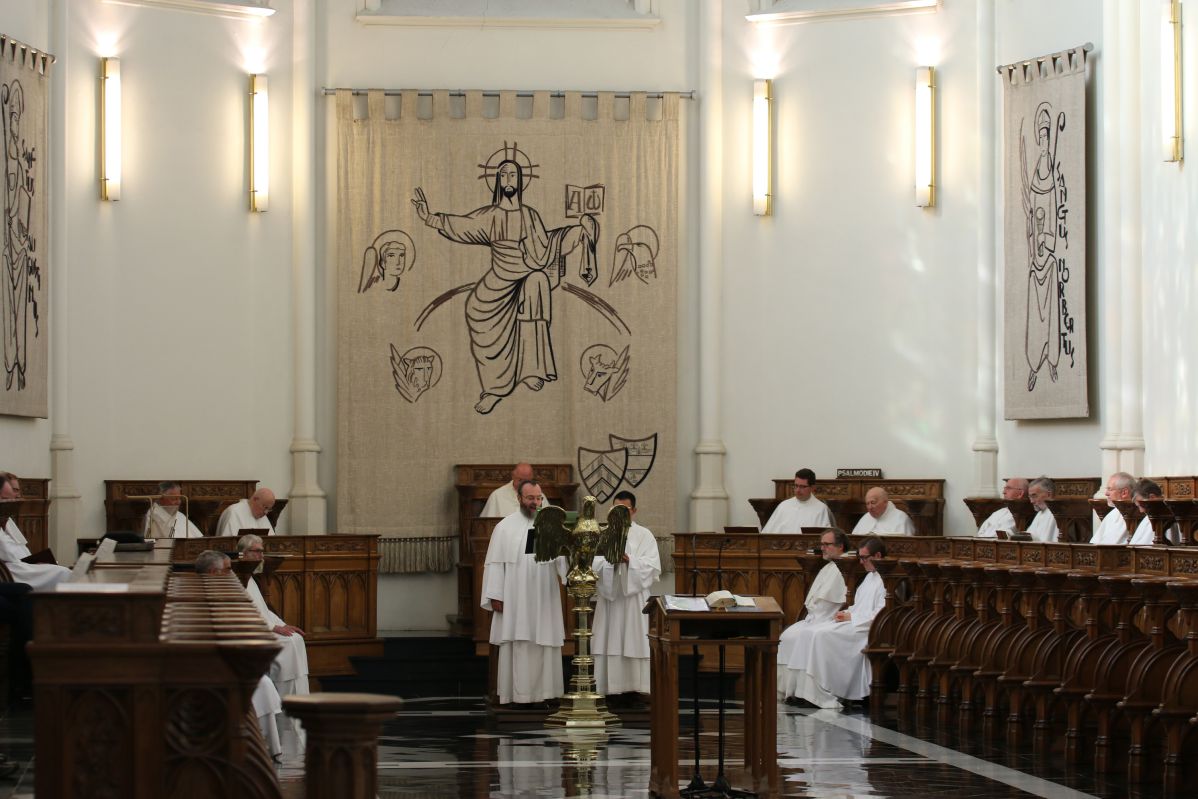 Norbertines at the church during the Vespers
Norbertines at the church during the Vespers.jpg) Bell in the barn.
Bell in the barn..jpg) Clock mechanism oin the barn
Clock mechanism oin the barn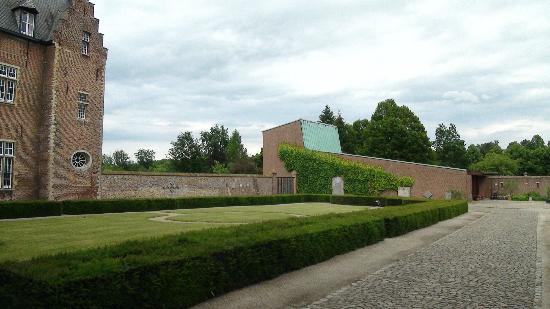 Da Vinci Museum
Da Vinci Museum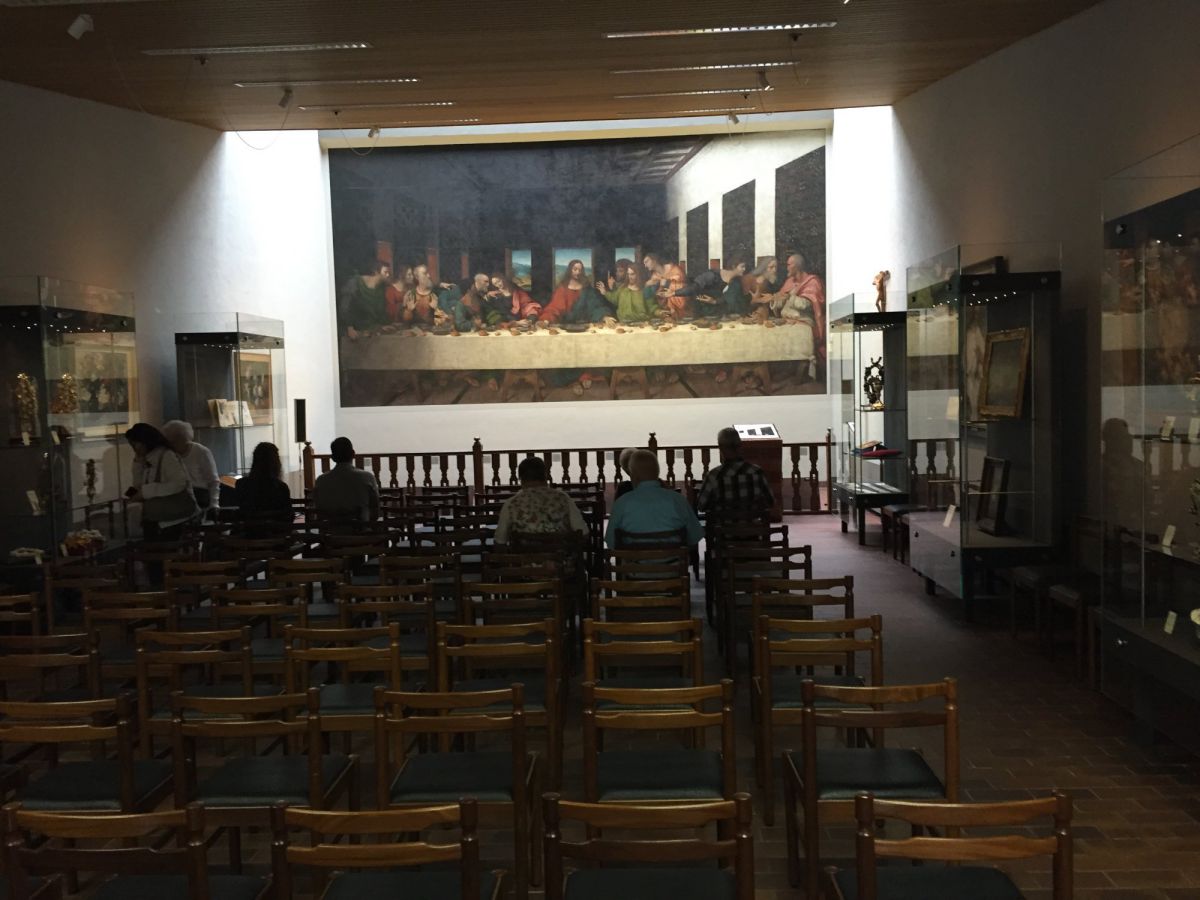 View from the entrance of the Museum.
View from the entrance of the Museum.Historical overview
The founding history of the Abbey of the Premonstratiensens of Tongerlo is not entirely clear. Presumably the abbey community was founded around 1130, during the life of Norbertus of Gennep (1084-1134). He founded the order ofPremonstratiensens in 1121, inspired by a an ecclesiastical renewal movement that strongly emphasized poverty, evangelical piety and community life.With the support of the first abbot of the Sint-Michielsabbey in Antwerpen, a double cloister was founded in Tongerlo, probably with the specific help of a few Antwerp Premonstratiensens. The double cloisters had men and women that had chosen the lifestyle of Norbertus and te regulation of Augustinus. Thanks to the donation of a domain by a local squire-Giselbert of Castelré”, later entered as a convert- the abbey community of Tongerlo could rely on a steady material base during the initiation years. Poverty was central in the lifestyle of the original community. Although reality did not permit the stern compliance with the poverty ideals of Norbertus. Within the frame of church reform, initiated by Pope Gregorius VII (1073-1085) numberous lords of domain and domain churches handed over the connected patronage rights and endowments at the ecclesiastical authorities.
Also the Abbey of Tongerlo acquired in the first centuries after its foundation a few parish churches from the area, among them in Tongero, Oevel, Broechem, Oelegem, Wijnegem, Ravels, Poppel, Diest (with the Mariakapel/Chapel of Mary), Alphen, Zundert, Hoogeloon and Tilburg the abbot of Tongerlo had the patronage rights. The transfers brought duties and rights to the abbey. In return of the Tiendenbelasting (Tithes Taxe) (for churches in properties) and the beneficials the Abbey had to take care of the pastoral needs and the maintenance of the parish priest and the buildings. In addition to the parish churches and the patronage rights the abbey also had a few outer courts in among other Eeuwen (Broechem), Kalmthout, Essen, Ierseke, Alphen, Ravels, Vissenaken and Wiekevorst. This formed the base for the larger religious, cultural and economical influence that the Abbey of Tongerlo had on its environment.
In the spirit of Norbertus the Abbey of Tongerlo initiated as a double cloister of men and women. The income of the abbey did not suffice to support the increasing sister community. Shortly after the foundation this was transferred to the outer court at Eeuwen. The convent disappeared in the 13th century. In 1410 the about Jan Geerts founded a new Premonstratiensens sister community in Herentals.
At the end of the 15th and 16th century the Abbey had known a certain prosperity and a large prestige under the abbatiat of Werner van Halleer (1480-1487), Antoon Tsgrooten (1487-1530) and Arnoud Streyters (1530-1560). The abbots engaged numberous architects and artists to rebuild the abbey complex and to embellish it. Although, also Tongerlo could not escape from the broader ecclesiastical and political developments.The Abbey became twice the victim of the batlle in between the Spanish authority and the Calvinists. In an attempt to reinforce the control over the restless areas, the Bishop of ’s Hertogenbosch became the protector of the Spanish rulers and at the early 1560’s he was appointed as Commandatory-abbot of the Abbey of Tongerlo. Until the canons of Tongerlo could buy their freedom against a high price-almost all possessions in Northern-Brabant went lost- this situation caused turmoil and many problems.
The Council of Trente succeded in covering up this abuses and it gave the Premonstratiensens the opportunity to fully express their own identity, piety and spirituality. Under abbot Adriaan Stalpaerts (1608-1629) this new contra-reformist elan got a definite herd.
He was also responsible for the foundation of the Sint-Norbertuscollege, an educational institute for Premonstratiensens from the Brabant abbeys, in Rome. But they were not completely out of danger since the Abbey of Tongerlo had to deal with the protestant threat. In 1637 the canons had to flee the rise of the Calvinists of ‘s-Hertogenbosch. Until 1640 they stayed at their refuge in Mechelen. The Premonstratiensens that were active within the parishes tried to hold their positions. Only with the Peace of Westfalen (1648) peace returned and the abbot Augustinus Wichmans could give attention again to the religious life and the apostolate of his abbey community, with a large concern about the Marian piety and the improvement of the pastoral needs.
Since the second half of the 17th century the Abbey of Tongerlo could breath again. In the 18th century the canons were captivated by scientific research. Numberous of subjects were studied at Tongerlo and in 1773, after the abolishment of the order of Jezuits, the editoral office of the Acta Sanctorium, that was the property of the Bollandists, was taken over by the Abbey.
At the end of the 18th century new problems arrived. Under abbot Godfried Hermans (1780-1799) the Abbey was involved in the Revolution of Brabant (1789). With the financial support of Tongerlo, there were two garrison of the Kempen in the battle against the Austrians. An action that was seen negatively by the Austrian authorities after their recovery. The Abbey was sequestrated. A few years later the French rule caused greater difficulties. In 1796 the 130 canons were driven away from Tongerlo. The abbey buildings became private property and were partly demolished. Only fourty years later, in 1835 the abbey could be re-initiated. There was a new abbey community and in 1838 the Abbey was ecclesiastically restored. The community stayed at a rented castle in Broechem at first, but moved partially to the former abbey buildings in Tongerlo in 1840.In the 19th and 20th century the Abbey of Tongerlo flourished again. In 1948 the number of members had reached a peak of 234 religious people. Also the apostolate functionings were retaken and expanded, also due to the foundation of the Congo mission. The canons were active in the pastoral works and the parishes. In the Abbey itself an eucharist liturgic movement was founded during the Interbellum, translated to the publication of a number of liturgic magazines such as the Algemeen Nederlandsch Eucharistisch Tijdschrift and Het Heilig Misoffer and the people’s missions in Belgium and the Netherlands of father Antoon van Clé.
Shortly after the Second World War another priest of Tongerlo, Werenfried van Straaten, was at the base of Oostpriesterhulp. Meanwhile the Abbey of Tongerlo was fully involved in the missionary and foundational work. In 1889 a first English community of Premonstratiensens was founded in Manchester. Later on the foundation in Crowle and Spalding followed and the take over of priory in Storrington. Since 1898 numberous priests and brothers went to the Uele-mission in Congo. Also in Ireland (Kilnacott) and Canada (Saint-Bernard-de-Lacolle/Quebec and later Saint-Constant/Montréal) there were new foundations from the Abbey of Tongerlo. Finally, in 1966 a number of former-missionaries went to Chile, where they founded two new establishments in Chiguayante and Santiago. In Belgian there were priests of Tongerlo at the base of the refoundation of the Leffe Abbey in 1929.
The second Vatican Council (1963-1965) became a milestone in the history of the Abbey of Tongerlo and the Premonstratiensens order. In 1968/1970 new statues were published, as a result of an intense reflection and contemplation. They intended to adjust an age-old tradition to a lifestyle that was in harmony with the spirit of Norbertus and with the changing current circumstances.
On the way home from Tongerlo, We pass the Municipality hall of Westerlo. Another historical building now occupied by the local goverment unit. This castle was build in the early 20th century as the residency of one person: Countess Jeanne de Mérode. Let's have a closer look at this majestic castle
Jeanne de Mérode was born in Paris in 1853 as a daughter of Charles-Antoine Ghislain de Mérode-Westerloo, Marquess of Westerlo and Princess Marie-Nicolette d'Arenberg. She remained unmarried and devoted her life to religion and charitable works. To provide employment for the population of Westerlo (especially for young girls and women) she founded a carpet factory in Westerlo.
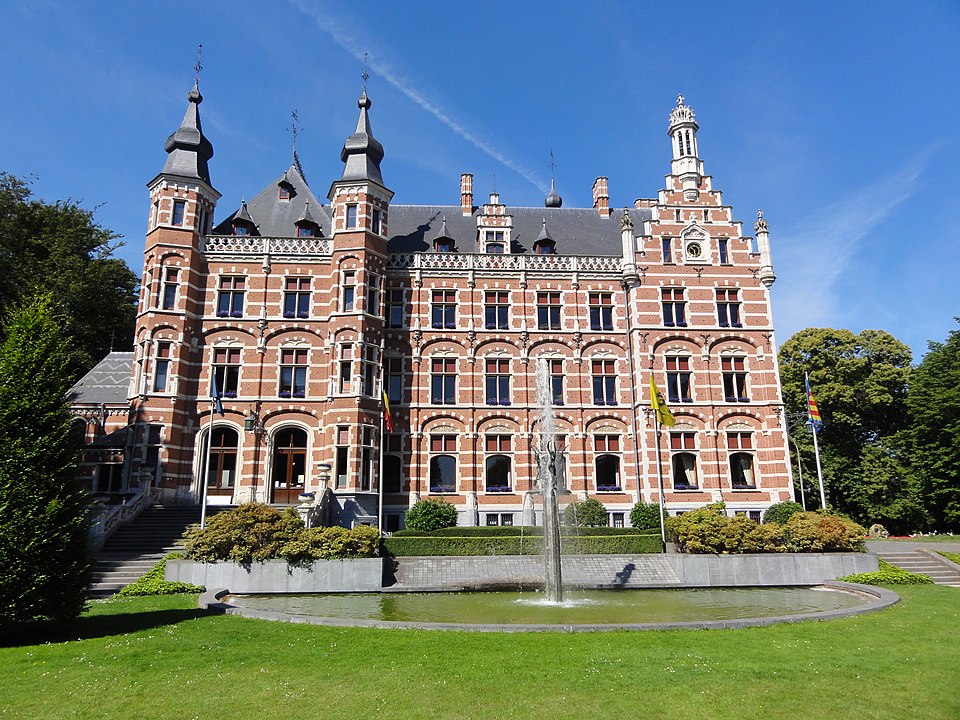 Front facade seen from the main entrace gate
Front facade seen from the main entrace gate.jpg) Castle entrance, or Municipality hall entrance.
Castle entrance, or Municipality hall entrance..jpg) Entrance, flanked with two towers
Entrance, flanked with two towers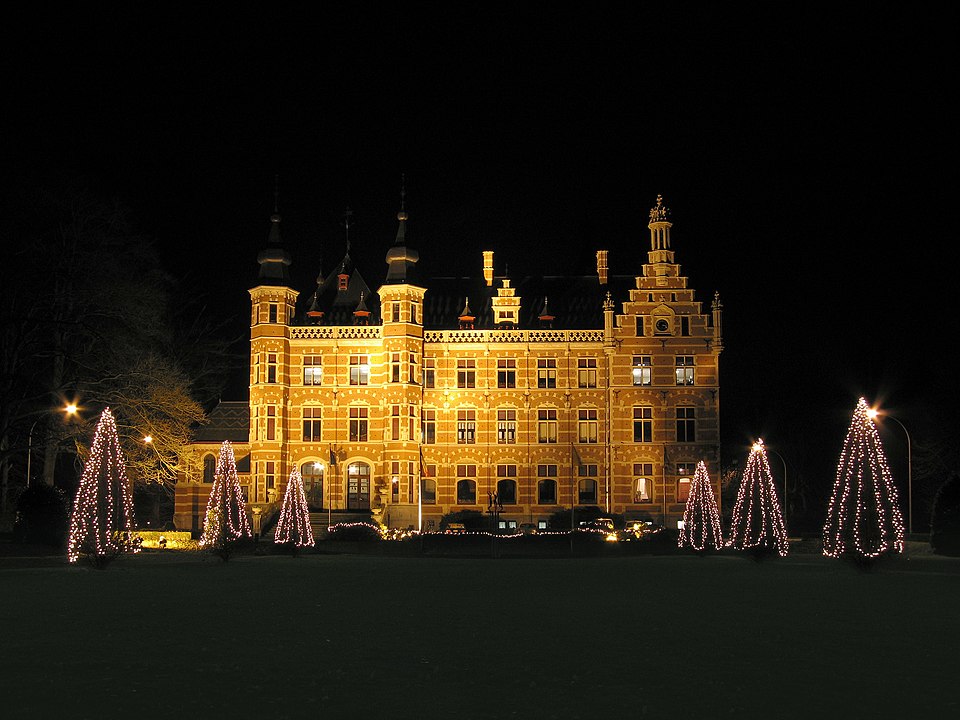 Christmas setting of the compound
Christmas setting of the compoundHistory
From the 14th century onwards, a branch of the Merode family gained power and possessions in the Duchy of Brabant and the Prince-Bishopric of Liège, on the territory of present-day Belgium. At that time, these territories belonged to the Burgundian Netherlands and later to the Habsburg Netherlands.
The marriage of Richard de Merode with Margareth van Wesemael marked a new age in the family’s history. Due to this marriage, the house of Merode inherited important seigniories in Brabant, such as Westerloo and the County of Olen. Jean I de Merode married Adelheid van Hoorn in 1451 and brought Gheel, Diepenbeek and Duffel into the possession of the family. Through these and other marriages, the Merode family became one of the most important noble families in the Duchy of Brabant.
Jean II de Merode held the position of Lord Chamberlain of Philip the Handsome. He was succeeded by his son Jean III. After his death in 1551 his heirs ordered a monumental sepulchre for him and his wife that was made by the Antwerp sculptor Cornelis Floris. It stands in the church of Gheel and was erected in 1554.
The Eighty Years War greatly damaged the possessions of the Merode family. In the more prosperous era after the Twelve Years' Truce, the family's fortune grew again. In 1626, the title of Marquis of Westerloo was granted to Philippe I de Merode by King Philip IV of Spain. It was his great-grandson, Jean-Philippe-Eugène de Merode, Marquis of Westerloo, who would become one of the most illustrious descendants of the house: He is known as the Feld-Maréchal de Merode and became a knight in the order of the Golden Fleece, having served as an important military commander.
In the 18th century, the branch of Merode-Westerloo acquired wealth and power due to the extinction of other branches of the house (Merode-Houffalize, Merode-Deinze, Merode-Montfort, Merode-Calvo) and a few very advantageous marriages.
Through marriage of Philippe-François de Mérode with Louise-Brigitte de Rubempré, they acquired the domains and titles of 'Princes of Rubempré' and 'Prince of Everberg'.
During the French Revolution, the Austrian Netherlands were invaded by French republican troops and were incorporated into the French Republic. The domains of the family were confiscated and noble privileges were abolished. The family fled to Germany for a while. It was only after the declaration of the Empire des Français by Napoleon in 1804 that the family could regain their domains and some of their titles. A re-introduction of the noble privileges, however, would never be achieved. As a result, members of the Merode family became prominently engaged in politics and diplomacy. Charles-Guillaume-Ghislain de Merode-Westerloo had been active as a minister under Austrian rule since 1787 and would hold several other important political posts under successive regimes, such as mayor of Brussels in 1805, and senator of the French Empire in 1809. In 1815, he became Grand-Marshal of the court of King William I of the Netherlands, when the Belgian provinces were part of the United Kingdom of the Netherlands.
His sons, Henri, Félix, Frédéric and Werner would play an important role in the Belgian revolution and in the political life of the Kingdom of Belgium. Frédéric de Merode became a new national hero when he was killed in the battle near Berchem during the Belgian revolution, while Félix de Merode became an important member of the Provisional Government of Belgium and the Belgian National Congress. After the first Belgian legislative elections, Henri de Merode became a senator, while his brothers Félix and Werner both became members of parliament.
The descendants of Henri, Félix and Werner de Merode would form different branches, whose descendants would continue to play an important role in Belgian politics and diplomacy.Wealth
The family is known for its large estates and old castles. In 2014, the House of Merode-Westerloo sold 1,476 hectares of privately owned land to the Flemish region.[1] Among the castles owned are Merode, Westerlo, Trelon, Serrant, Rixensart, Everberg, Solre-sur-Sambre and Neffe.
While the Church of Our Lady or "Onze-Lieve-Vrouwekerk" definitely leaves its mark on the appearance of the city, nothing defines Aarschot better than the river that passes through it: the Demer. Aarschot is situated in the valley of this brown-colored river.
With may schools present it attracks pupils form the neighbouring towns, just like Luc who spent all of it schoolyears in Aarschot.
Aarschot was hit very hard in World War I. When German troops occupied the city on 19 August 1914, Colonel Stenger, commander of the 8th German Infantry Brigade, was shot dead on the balcony of the town hall. The German reprisal was extremely harsh. Many houses were set alight and 156 people were executed, including Mayor Tielemans and his 15-year-old son. The next day, the entire population was ordered to evacuate the city.
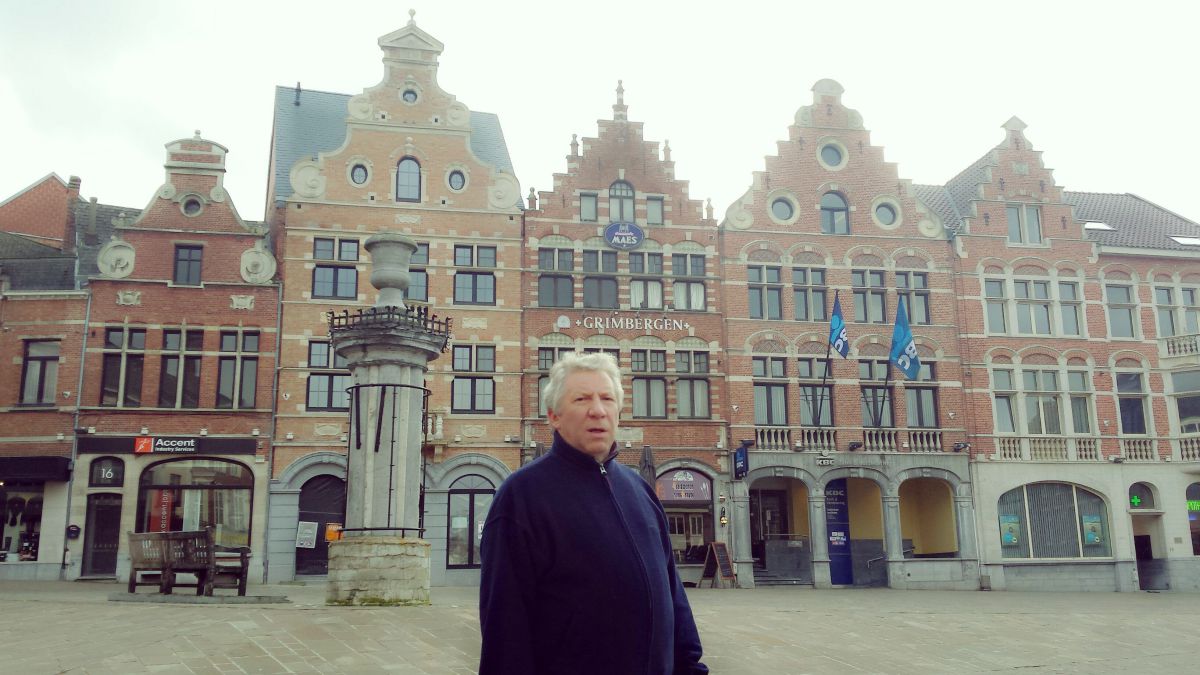 Grand Market or "Grote markt" anno 2015. The famous pump in sight. The market is pedestrianised with the exception of local dwellers/deliveries
Grand Market or "Grote markt" anno 2015. The famous pump in sight. The market is pedestrianised with the exception of local dwellers/deliveries 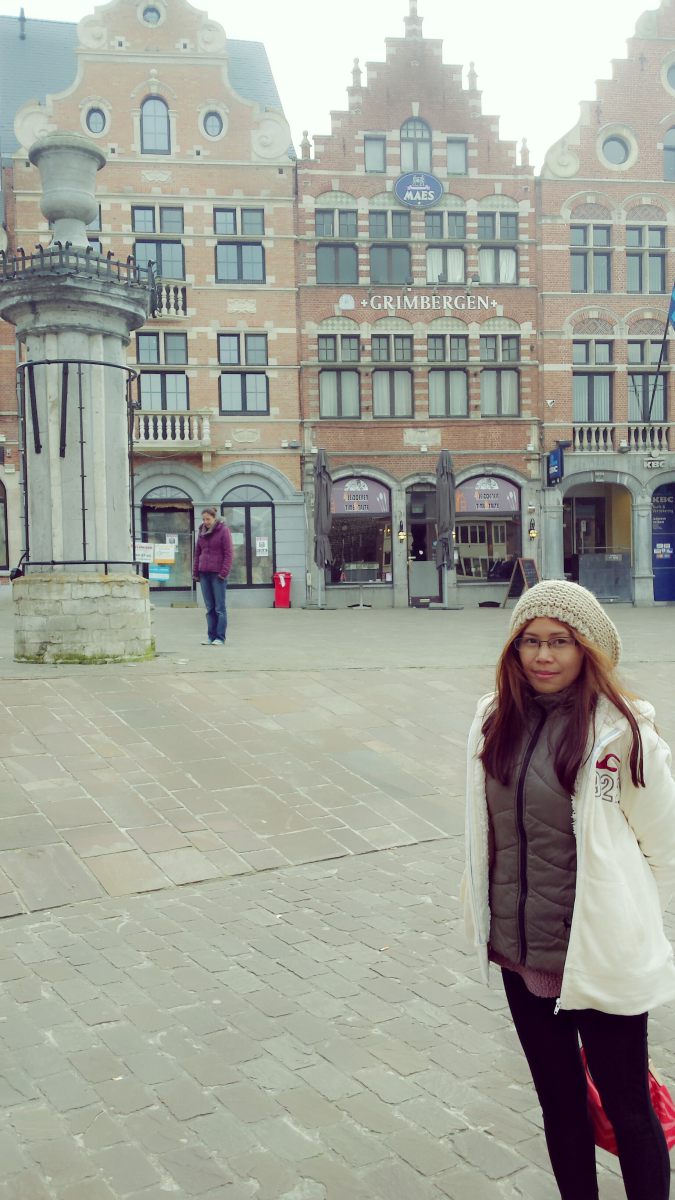
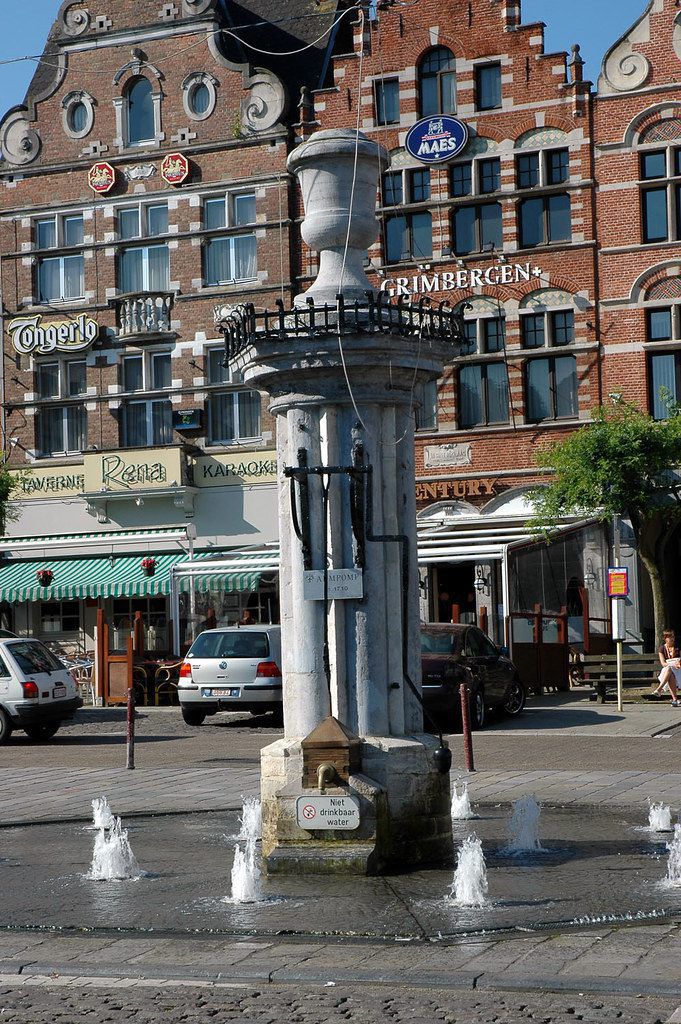
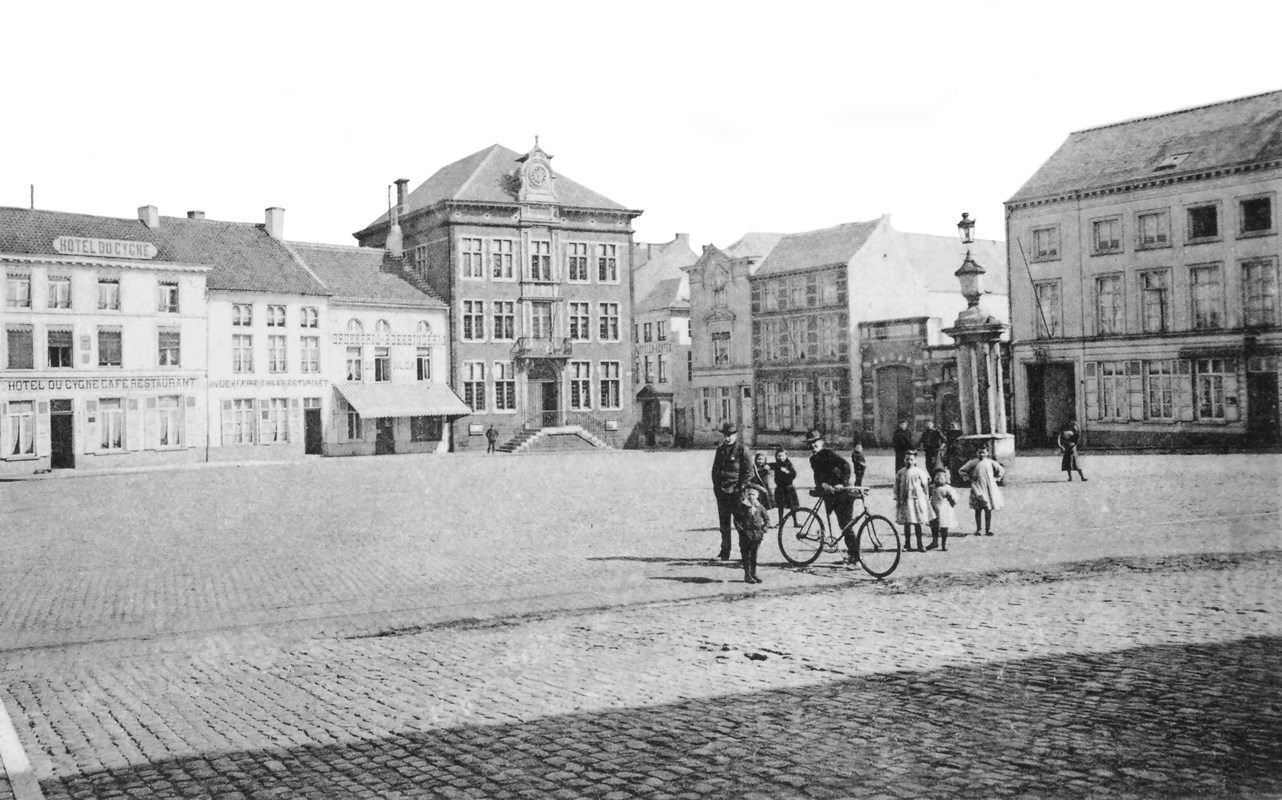 The Market in older days. Not much traffic either.
The Market in older days. Not much traffic either.Pump is the same spot
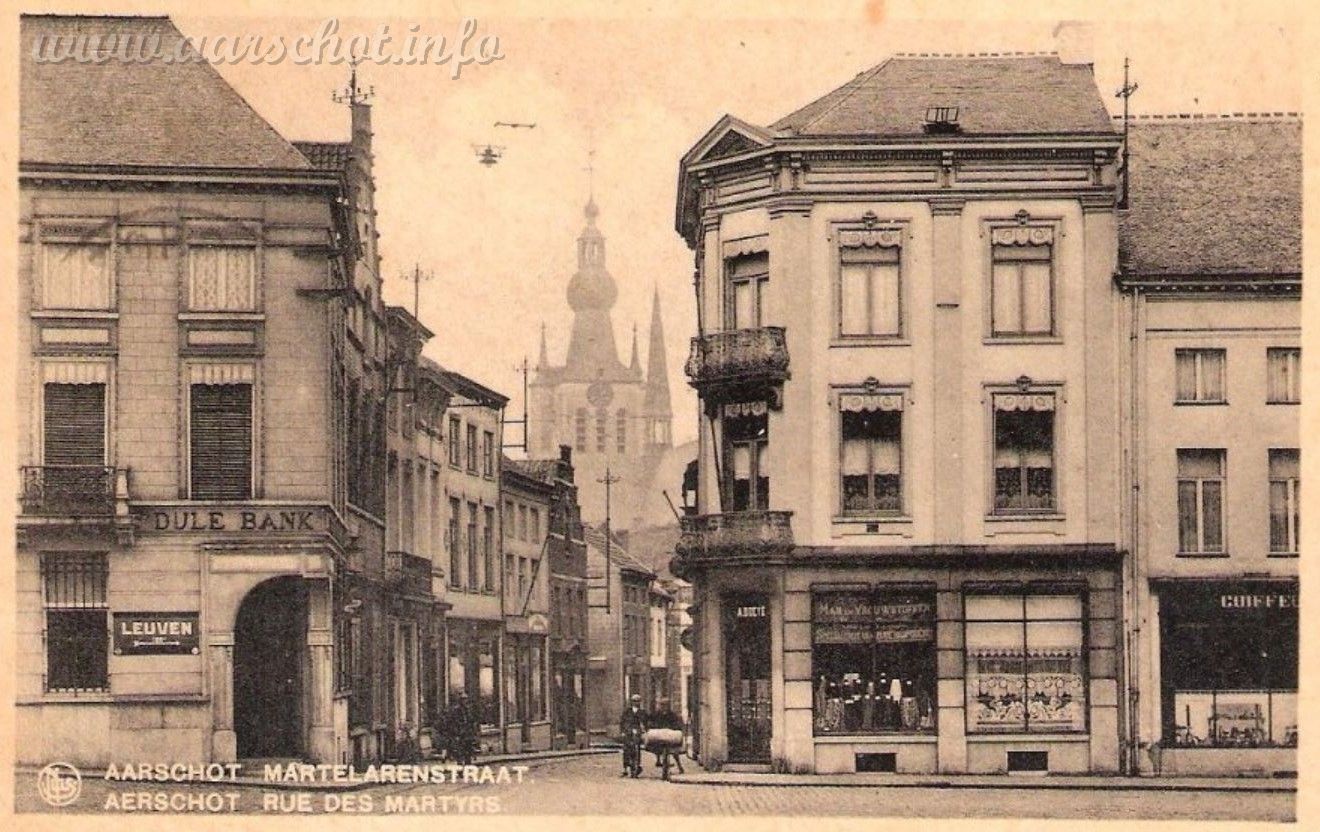 View from the Grand Market to the Martelarenstraat, today's shopping street, also traffic free.
View from the Grand Market to the Martelarenstraat, today's shopping street, also traffic free.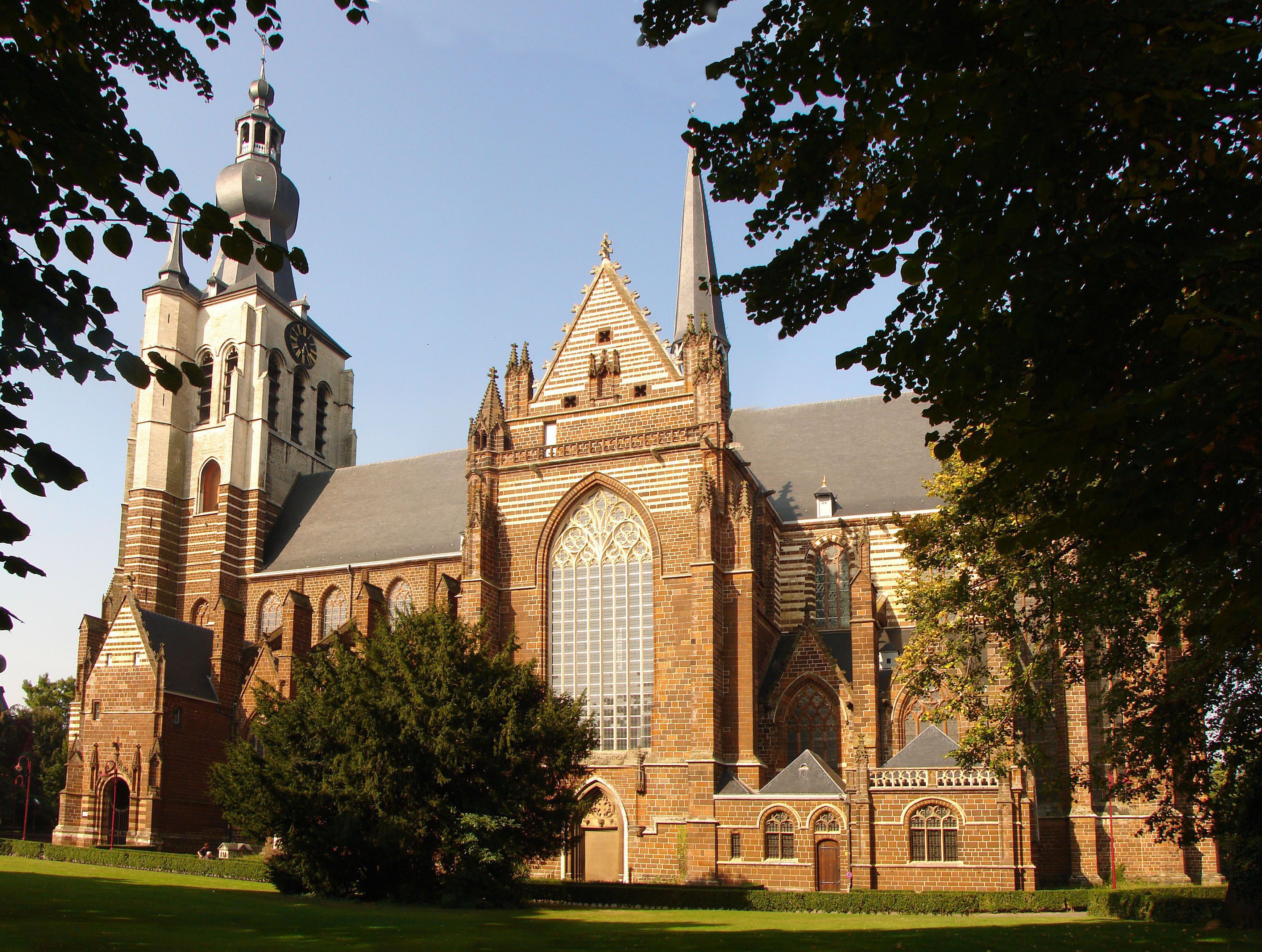
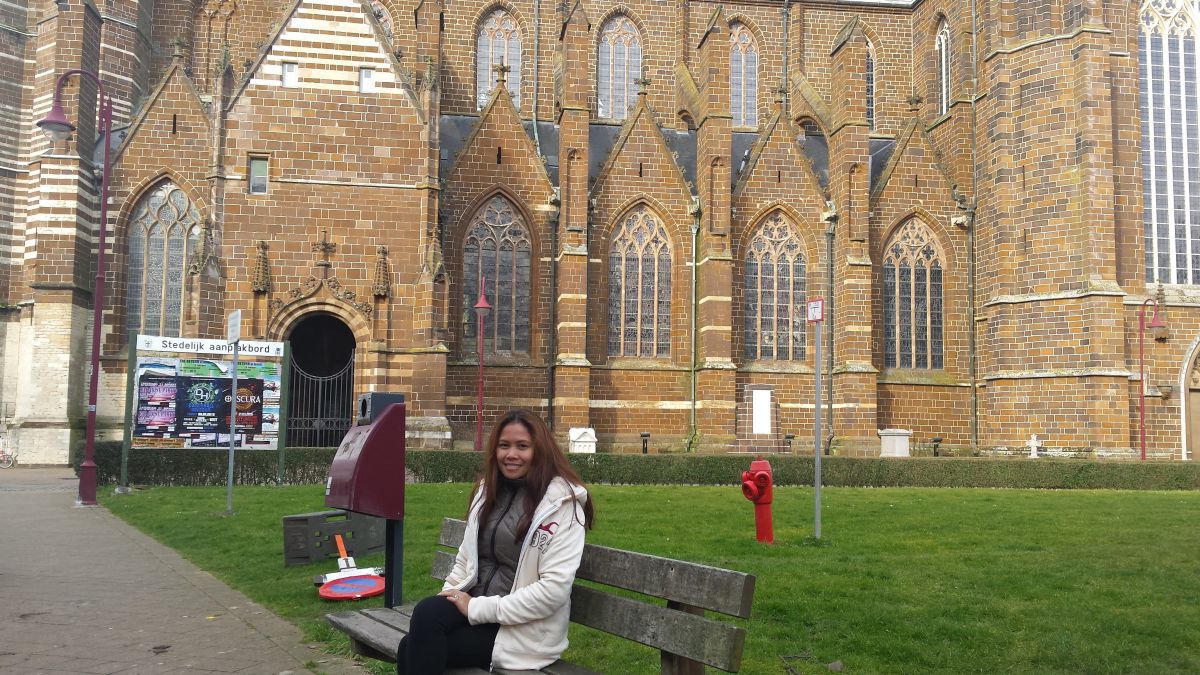 Jas posing in front of Church of Our Lady or
Jas posing in front of Church of Our Lady or"Onze Lieve Vrouwe Kerk"
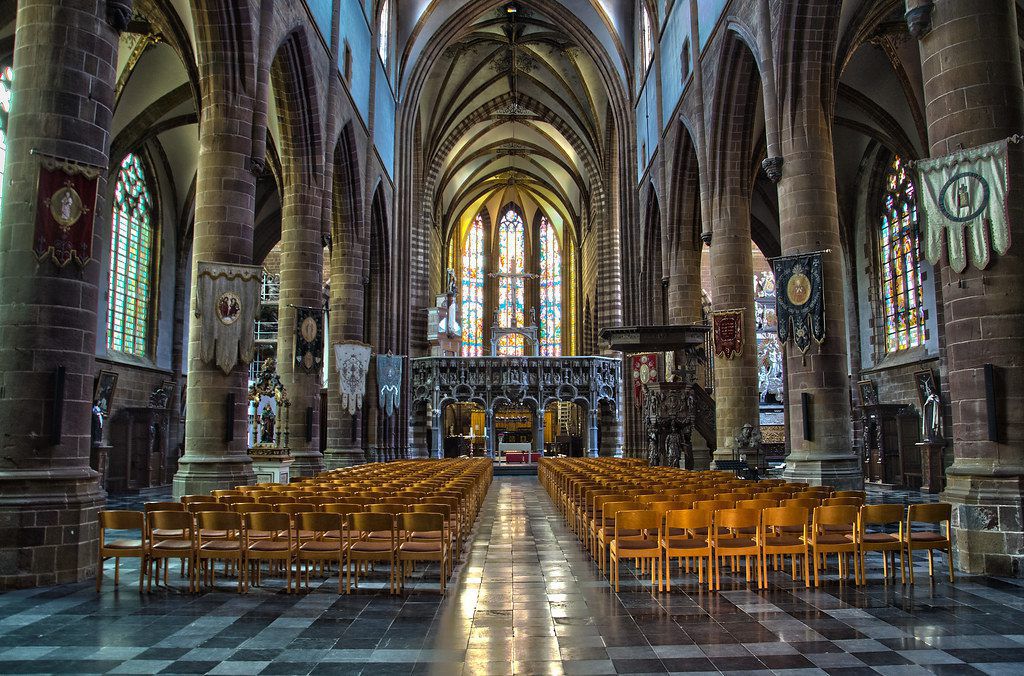 Interior of the church of Our Lady
Interior of the church of Our Lady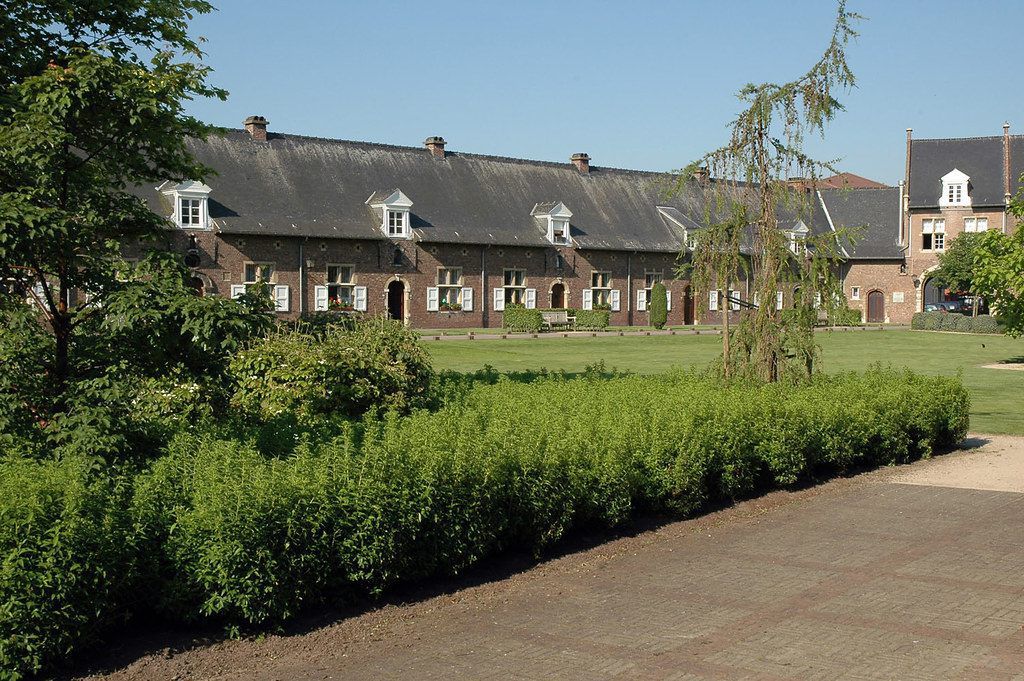 In the shade of the church tower, the beguinage of Aarschot
In the shade of the church tower, the beguinage of Aarschot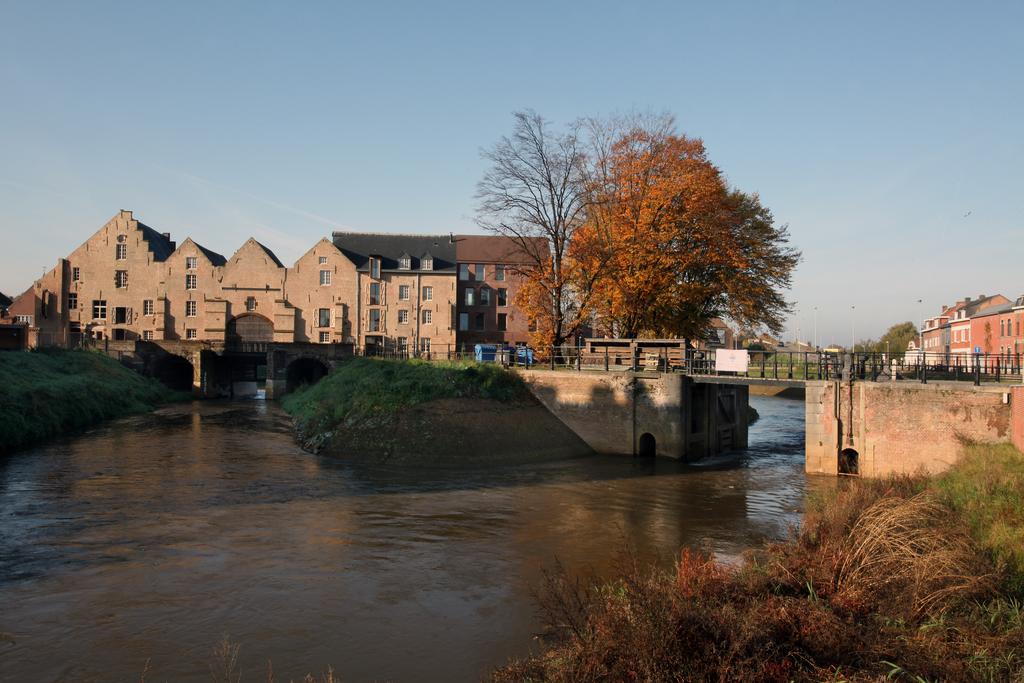 's Hertogenmolens on the Demer. Restored and converted to Hotel. A levy runs around the compound
's Hertogenmolens on the Demer. Restored and converted to Hotel. A levy runs around the compoundIf all this culture intake makes you thirsty, that is very understandable. Time to get hydrated with a few beers named after the monistaries we visited. The beers don’t have to be brewed in or in the neighborhood of the abbey but there has to be a demonstrable, historical connection with the abbey site the beer refers to. Furthermore the brewery has to pay royalties to the abbey and the abbey may also check the marketing strategy and publicity material.
Add some pastries and perhaps a chocolat, this is Belgium! Maybe it's time for a hearty meal; your choice of bread with cheese or ham or other choices of coldcuts? Enjoy the great tastes this country has to offer.
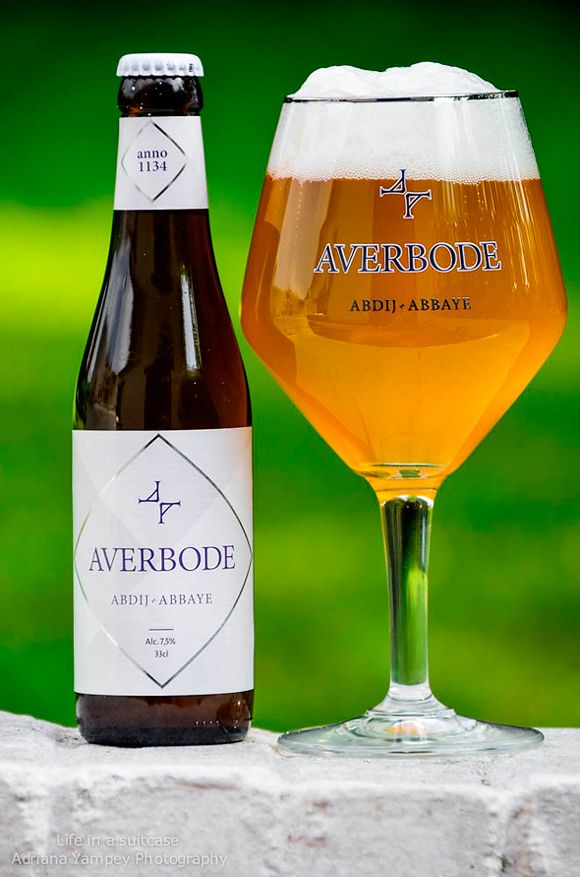
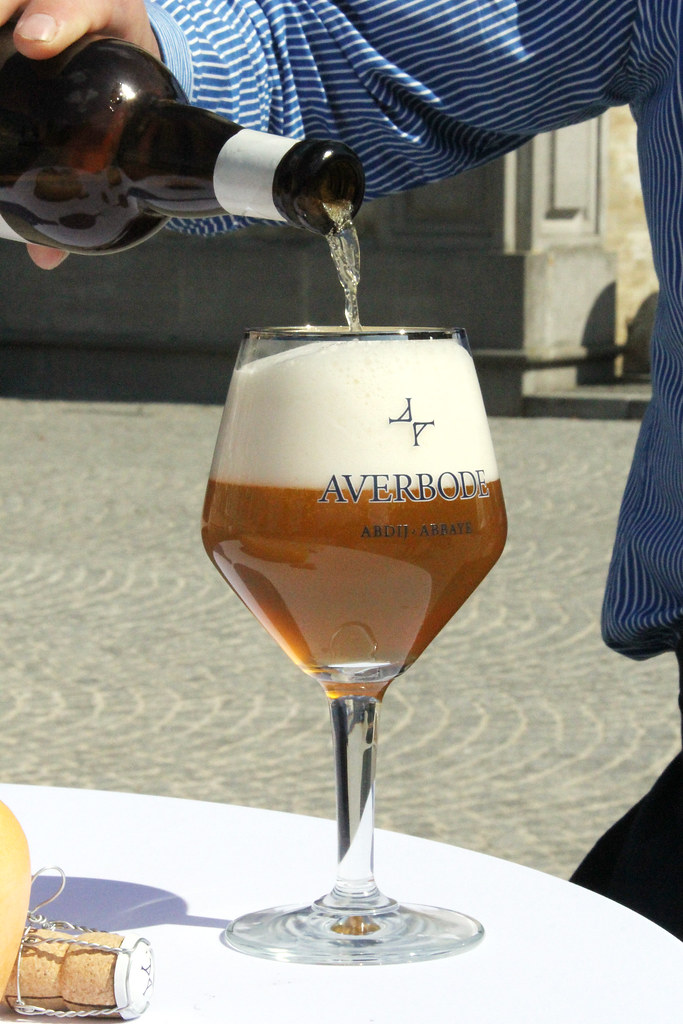
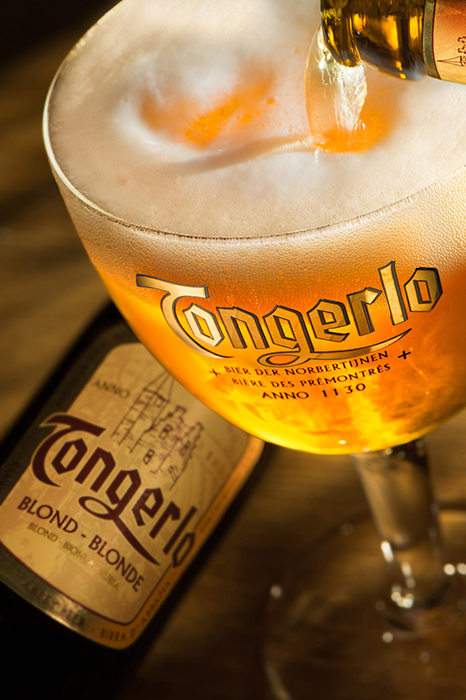

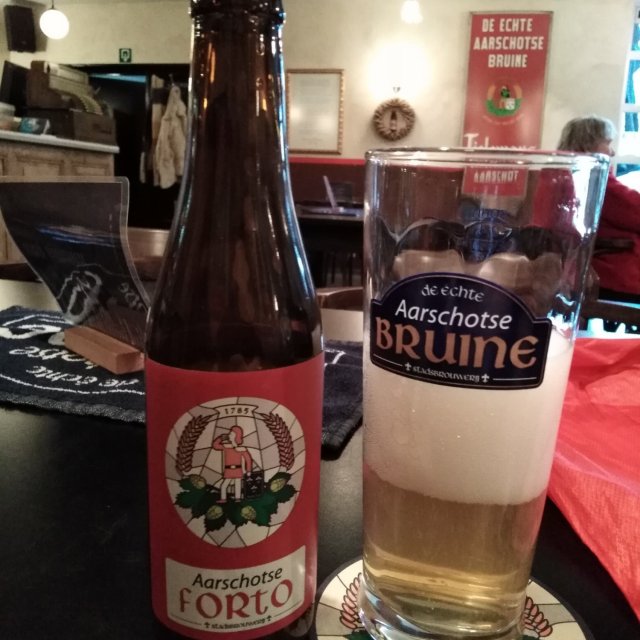 Aarschotse bruine, Forto
Aarschotse bruine, Forto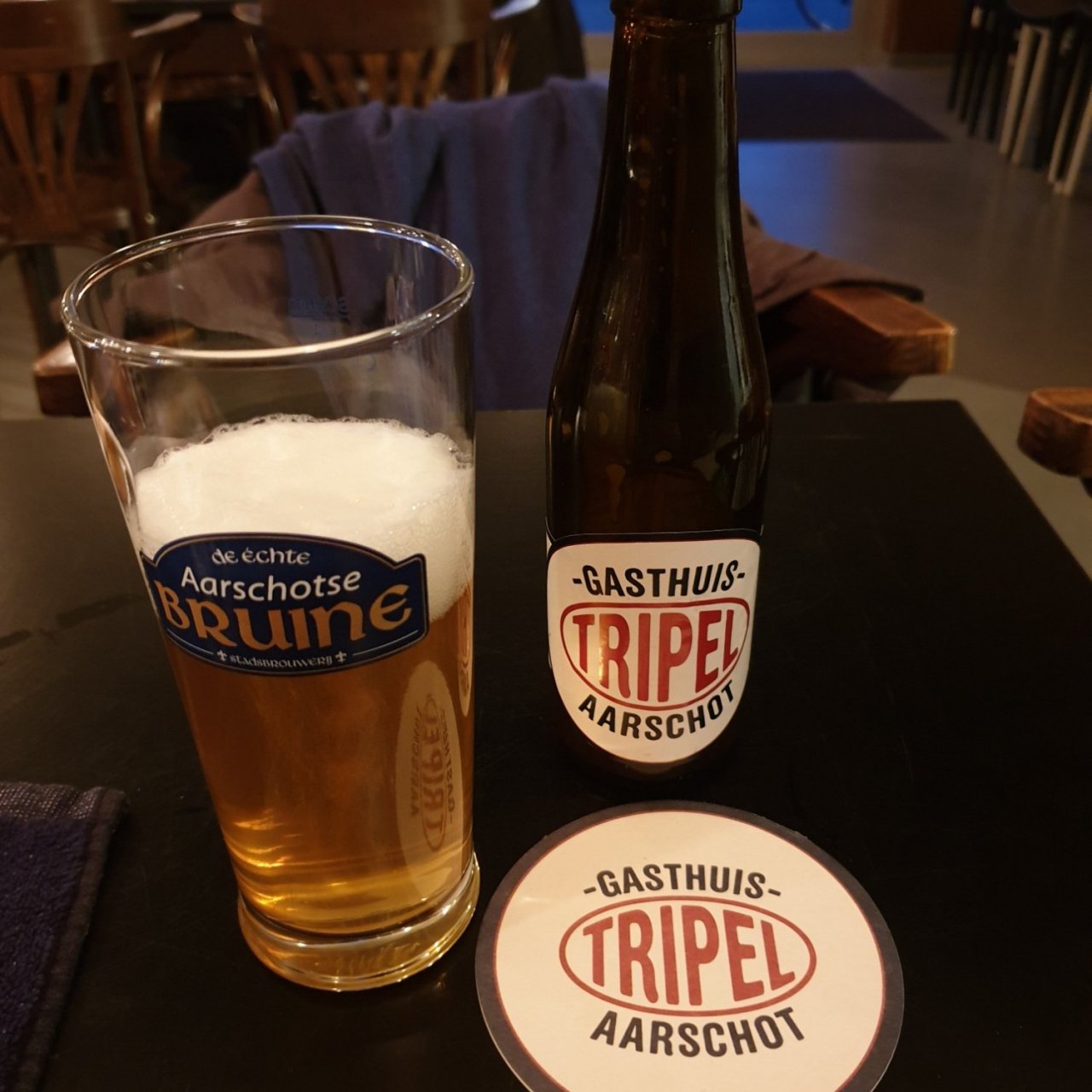 >Aarschotse bruine, Gasthuis trippel
>Aarschotse bruine, Gasthuis trippel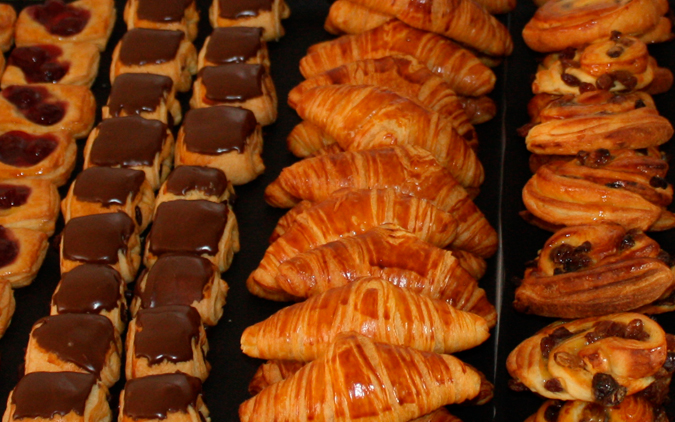 Assorted pastries
Assorted pastries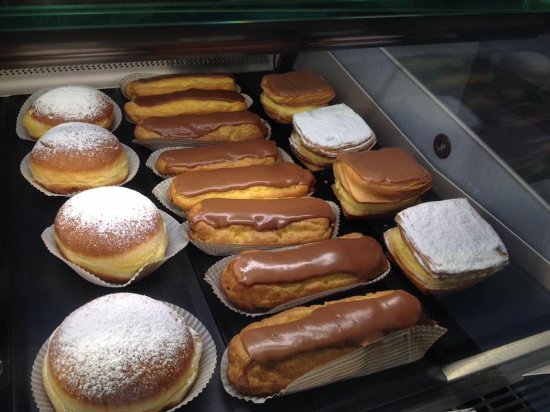 Pastries every baker has
Pastries every baker has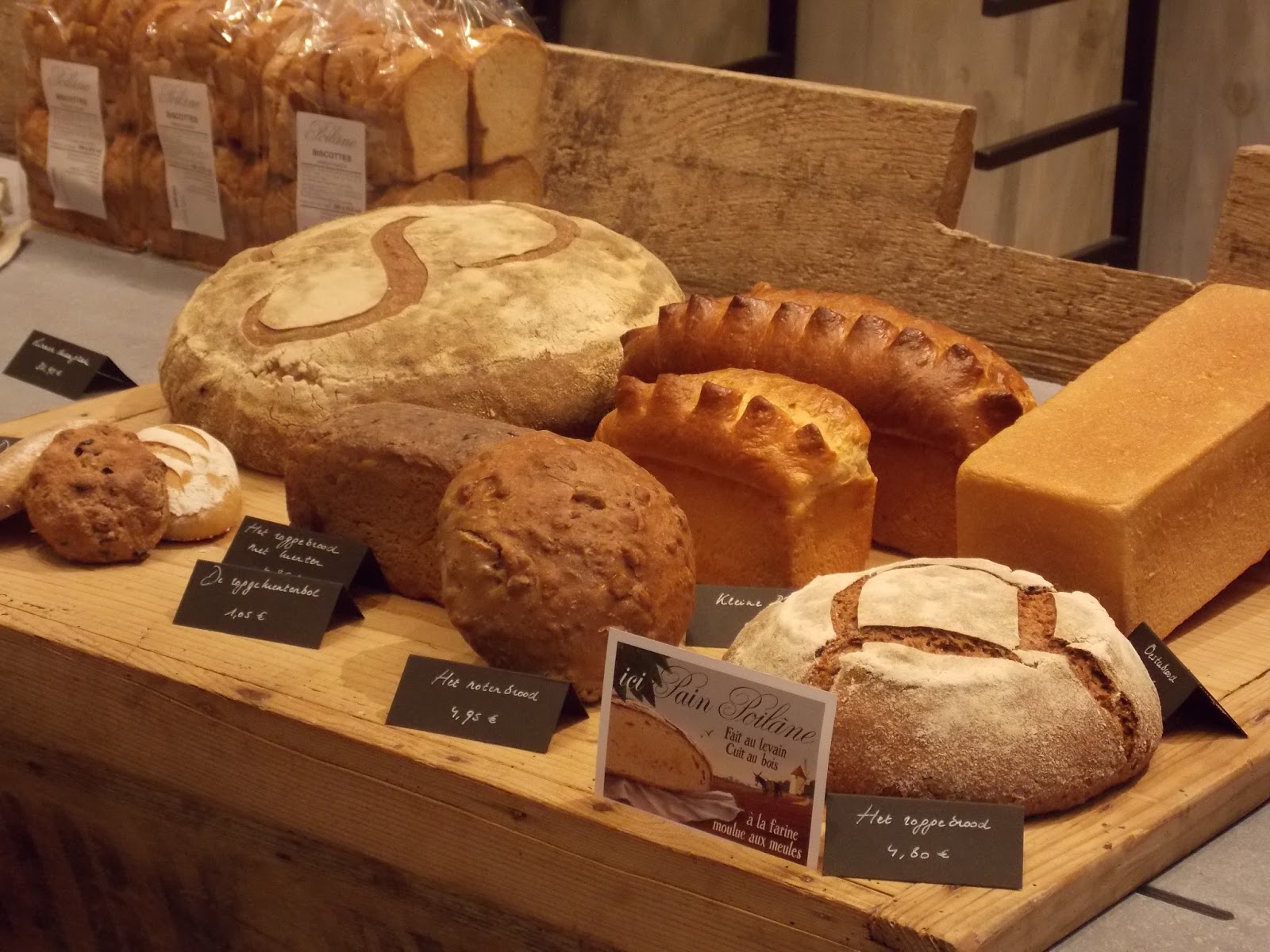 Assorted Belgian breads
Assorted Belgian breads

Comments powered by CComment